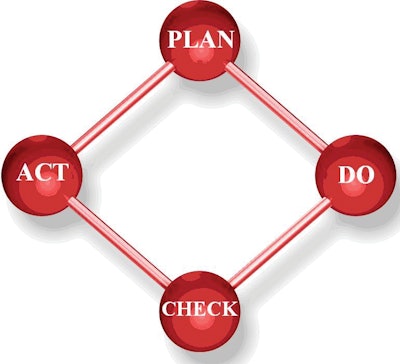
After attending a dinner party for a client who was celebrating with the entire team for meeting its sales goal for the year, I reflected on the reasons the company has practically doubled in size over the last four years. I can pinpoint several things:
- They are a talented group of people.
- They set realistic but lofty goals.
- They execute very well.
- They all work very hard. Long hours are part of their culture.
- They are not afraid to make mistakes.
- They look at their mistakes to learn what went wrong and what went right.
- They have a leader that has vision.
One thing I can tell you about this company is they are constantly practicing the Plan-Do-Check-Act Cycle (PDCA). It is often referred to as the "Deming Cycle". You may have heard about it looking into or reading about Total Quality Management, Six Sigma or ISO certification programs.
The concept is simple:
- PLAN - Figure out what you need to do.
- DO - Execute your plan.
- CHECK - Measure your results. Analyze the variance from plan.
- ACT - Take action. Make a decision whether to continue on same path or make a change.
Rinse and repeat. Make refinements and repeat the cycle continuously.
The system is so effective because of its simplicity. It breaks down the phases in basic terms and concepts that prevent companies from getting bogged down in such an elaborate methodology that even if the planning stage is completed the execution is lacking. Executing the plan may seem like the success but it is just the mid-point of an
ongoing process.
Think about your own company or department. What changes have you thought about? Have you tried implementing them? If you answer yes to these two questions we offer you applause. You have gotten farther along than many, but now you must collect data and interpret it. This allows you to evaluate how you did in your planning and execution
phases.
Gathering accurate data on what happened and comparing it to the desired outcome (plan) is how you will know what is working and what needs to be fixed or improved.
The results of the data can be amazing. Often small tweaks or calibrations can produce huge improvements. If you had a good plan and executed well you may only need small
incremental changes.
PDCA is the foundational mindset for long-term strategic planning. When you develop your strategic plan it includes several components that are stand alone; however, their
successful integration with the other dynamics of the SP is critical to overall success.
Let me give you an example. The client I mentioned above decided to grow its business. The plan included many things:
- Becoming part of a national network to help benchmark themselves amongst other industry leaders.
- Developing a marketing plan for the right kind of lead generation.
- Coaching the sales team into working on their strengths.
- Adding the right equipment to the fleet to increase productivity.
- Raising the level of customer service to continue to bring in and keep the best clients.
All of the above were part of the plan. All of them worked because they practiced the four simple PDCA steps.




















